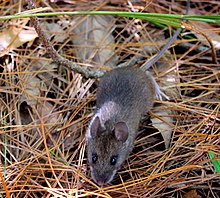Taiwan field mouse
| Taiwan field mouse | |
|---|---|

| |
| Scientific classification | |
| Kingdom: | |
| Phylum: | |
| Class: | |
| Order: | |
| Family: | |
| Genus: | |
| Species: | A. semotus
|
| Binomial name | |
| Apodemus semotus Thomas, 1908
| |
The Taiwan field mouse, also called Formosan wood mouse (Apodemus semotus), is a species of rodent in the family Muridae. It is found only in Taiwan. The Taiwan field mouse is primarily distributed in the montane region between 1,400 to 3,000 m. [1] They inhabit various habitat types, such as natural or planted forests, grasslands, farms, and campsites, and are omnivorous feeding on plants, insects and fungi. [2]
Based on morphological measurements, it has been suggested that the Taiwan field mouse is not different from the South China field mouse (Apodemus draco), and should not be considered as a separate species.[3]
The Taiwan field mouse is sexually dimorphic, with male generally larger than females (male: 25.6 ± 0.5 g; female: 23.8 ± 0.5 g[4]). Mark-capture-recapture data suggest that their life span may be less than 1 year in wild.[5]
References
- ^ Yu, H. T. (1994). "Distribution and abundance of small mammals along a subtropical elevational gradient in central Taiwan". Journal of Zoology. 234 (4): 577–600. doi:10.1111/j.1469-7998.1994.tb04866.x.
- ^ Lin, L. K.; Shiraishi, S. (1992). Demography of the Formosan wood mouse Apodemus semotus. Journal Faculty Agriculture, Kyushu University 36 (3.4): 245-266.
- ^ Kaneko, Y. (2011). "Taxonomic status of Apodemus semotus in Taiwan by morphometrical comparison with A. draco, A. peninsulae and A. latronum in China, Korea and Myanmar". Mammal Study. 36: 11–22. doi:10.3106/041.036.0102.
- ^ Lin, J. W.; Lo, H. Y.; Wang, H. C.; Shaner, P. J. L. (2014). "The effects of mite parasitism on the reproduction and survival of the Taiwan field mice (Apodemus semotus)". Zoological Studies. 53. doi:10.1186/s40555-014-0079-2.
{{cite journal}}: CS1 maint: unflagged free DOI (link) - ^ Shaner, P. L., Wu, S. H., Ke, L., Kao, S. J. (2013). Trophic divergence reduces survival in an omnivorous rodent. Evolutionary Ecology Research "15": 1–14.
- Baillie, J. 1996. Apodemus semotus. 2006 IUCN Red List of Threatened Species. Downloaded on 19 July 2007.
- Musser, G. G.; Carleton, M. D. (2005). "Superfamily Muroidea". In Wilson, D. E.; Reeder, D. M. (eds.). Mammal Species of the World: A Taxonomic and Geographic Reference (3rd ed.). Johns Hopkins University Press. pp. 894–1531. ISBN 978-0-8018-8221-0. OCLC 62265494.

